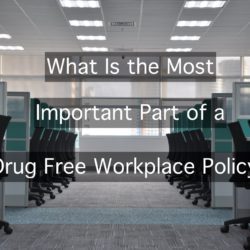This information is provided for educational purposes only. Reader retains full responsibility for the use of the information contained herein.
A policy is an indispensable component of an effective drug testing program but what specifically is the most important component of the policy? Is it the purpose statement? No. The program objectives? That is a great starting place, but nope. Then it must be the types of tests required? Wrong again. Perhaps it is the legal requirements? Extremely important but not most important.
A written policy is the first line of defense for employers and establishes the program expectations for employees. The policy sets forth the company’s rules and procedures and can be utilized to justify disciplinary decisions. When those decisions are challenged, the policy is front and center. Therefore, the most important part of a policy isn’t a specific piece, it is a combination of elements that work together. A policy is like a puzzle, without all the right pieces, the development is incomplete.
What Should a Policy Contain?
There are many critical parts to a policy and the most important piece may just depend upon who is asked this question. However, a written drug free policy should contain at a minimum the following important elements.
-
The program objectives
The most common reason for drug testing is safety—the safety of employees, clients, and the public while protecting the company’s property, equipment, operations, and profitability. However, is there an interest in establishing a program that meets the requirement to disqualify individuals for receiving benefits for workers’ and unemployment compensation purposes? Or is it your goal to obtain a discount on workers’ compensation premiums? Possibly the federal government requires the implementation of the testing program. If so, the need to meet these federal or state government regulations should also be stated.
-
The applicable laws
Employers should be aware of the different types of state laws and federal regulations and how they affect the testing program. Employers who understand different applicable legal requirements benefit by being in compliance with those requirements.
The types of state laws and federal regulations include, but are not limited to, the following:
-
- Mandatory requirements
- Workers’ compensation premium reduction requirements
- Workers’ compensation/unemployment compensation denial requirements
- Limited legal protection requirements
- Medical marijuana requirements
- Case law
- The Omnibus Transportation Employee Testing Act
- The Drug-Free Workplace Act
- The Americans with Disabilities Act
- The Occupational Safety and Health Act
-
Who is covered under the program?
This determination should be based on the types of jobs you offer and the objectives of your policy. Employers may elect to include all employees or limit testing to job applicants or employees with certain job functions. For instance, employees that operate motor vehicles or heavy equipment. Also, will temporary, contracted, or seasonal employees be subject to the testing program? This should be clearly spelled out in the policy to preclude any question on who must follow the testing rules.
-
The substances
When you decide to test your employees, it is important to choose a drug test panel appropriate to meet your program needs, industry standards and applicable laws. There are several panel options to choose from and the right panel may vary from company to company.
There are many factors that may determine which substances should be included in a test panel. Such as whether your company operates in state that places conditions on pre-employment testing for marijuana or if you are mandated to comply with federal Department of Transportation (DOT) regulations or a state law which may delineate which substances can be included as part of your program.
Perhaps most important, employers should test for the drugs people are using. Marijuana, cocaine, heroin, amphetamines and synthetic opioids are among the substances most commonly abused. Alcohol, also is a much abused drug.
Including the substances that are prohibited in your policy establishes the restrictions and requirements on workplace testing and informs employees and applicants of the company stance for illegal and legal substances.
-
Specimens for testing
Choosing the appropriate specimen type is imperative to achieve the desired drug testing objectives. Each specimen type has its strengths and weaknesses. Depending on the reasons behind your drug testing program, a given specimen type may fit more logically than another. As laws and regulations evolve, employers are shifting their interest from traditional single-specimen programs to a combination of different specimens to keep up with the evolution of workplace drug testing. Urine, oral fluid and hair are the only three testing methods endorsed by the federal government. There are several considerations when evaluating specimen options such as state laws, drug test panel preferences/requirements, and timing. However, after careful consideration, the appropriate specimen of choice should be included in the policy.
-
Policy prohibition
While it may be obvious that all illegal drug use on company time should be prohibited, what will the policy say concerning off-duty use, criminal drug convictions, and being at work under the influence of illegal drugs even though the use took place elsewhere? What about the misuse of prescription and over-the-counter medications? The prohibitions will provide clear direction for employees on what is or is not acceptable behavior.
-
Testing methodology
There is the traditional urine laboratory-based testing to consider or maybe there is a need for a quick turnaround time therefore instant/Point of Care Testing (POCT) could be contemplated. Keep in mind, there are numerous instant testing devices to choose from and some are urine based and others are oral fluid based. In addition, there is oral fluid and hair laboratory-based testing in addition to urine. If alcohol testing is included in the testing program, there are instant breath and saliva testing devices and laboratory-based testing methodologies.
-
Drug and alcohol testing procedures
Clarifying testing procedures is important so that employees can ensure proper procedures are followed. Certain procedures may be extensive, and it is important not to clutter the policy with step-by-step instructions, so it may be necessary to establish a separate procedures document but link it throughout the policy.
-
Medical marijuana
Will medical marijuana be permitted in the workplace, or will it be subject to disciplinary actions? Although each state law varies, generally it is not required to permit drug use in the workplace or tolerate employees who report to work under the influence of marijuana regardless of the drug’s legal status in a particular state. On the other hand, there are nuances that must be followed, and the policy will ensure proper policies and procedures are followed.
Conclusion
If you are interested in more information on how to create the right type of drug-free workplace program to meet your unique needs, contact the Current Consulting Group (CCG). CCG can help you tailor a program and testing panel that will work for your company. Contact CCG at 215-240-8204 or policy@currentconsultinggroup.com for more information.



